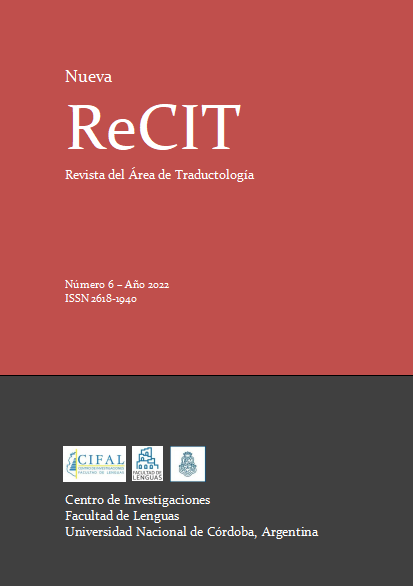Trainee translators’ use of digital technologies: An exploratory-descriptive study based on key-logging
Palabras clave:
translation, gradual training, free CAT tools, digital technologies, key-loggingResumen
This paper presents an exploratory-descriptive study that investigates the patterns in the user activity during translation evaluations with free digital technologies such as online resources, a CAT tool and a word processor. The study bases its analyses on a combination of qualitative and quantitative data collected by key-logging in a natural learning context. These were random samples made from evaluations in technical translation of undergraduate students. A wide range of data including keyboard logs, mouse logs, time used, no-key activity and screenshots was analysed. The findings demonstrate that all participants fulfilled the translation evaluations by carrying out the basic functions of a free CAT tool within which we considered the source text loading, the translation of segments, the tag management, the glossary usage, the dictionary usage, and the target text generation. Most of the trainee translators reproduced the visual aspect of the source text in the target text. The amount of time the students allocated to the usage of a free CAT tool, a free word processor and free online resources for documentation and terminology management led to time differences among them. The results show that after undergoing a specific gradual training, pre-trained translators can complete a whole computer-assisted translation process during evaluation sessions.
Referencias
Berrocoso, J. V., Arroyo, M. D. C. G., & Sánchez, R. F. (2010). Enseñar y aprender con tecnologías: un modelo teórico para las buenas prácticas con TIC. Teoría de la Educación. Educación y Cultura en la Sociedad de la Información, 11(1), 203-229.
Carl, M. (2012). Translog-II: A program for recording user activity data for empirical reading and writing research. Proceedings of the Eighth International Conference on Language Resources and Evaluation, 4108-4112. Istanbul, Turkey: Department of International Language Studies and Computational Linguistics.
Estrella, P., Lafuente, R. & Bruno, L. (2017). Broadening the scope of translation process research with ResearchLogger. Proceedings of the 10th Leipzig International Conference on Translation & Interpretation Studies Translation 4.0 – Translation in the digital age (LICTRA), 51-52. Leipzig, Germany: Institute of Applied Linguistics and Translatology.
Gamero Pérez, S., & Hurtado Albir, A. (1999). La enseñanza de la traducción especializada. In: Hurtado, A. (Ed). Enseñar a traducir. Metodología en la formación de traductores e intérpretes, 139-195. Madrid: Edelsa
Gil, J. R. B., & Pym, A. (2006). Technology and translation (a pedagogical overview). In Pym, A., Perekrestenko A., Starink, B. (eds.), Translation Technology and its Teaching, Intercultural Studies Group, Universitat Rovira i Virgili, Tarragona.
Grijalba, W. A., Castillo, J. A., Campos, R. A., & Estrella, P. (2018). Process-based assessment of computer science students. 2018 XIII Latin American Conference on Learning Technologies (LACLO), 363-370. IEEE.
Hurtado Albir, A. (2015). The acquisition of translation competence. Competences, tasks, and assessment in translator training. Meta: Journal des traducteurs/Meta: Translators’ Journal, 60(2), 256-280.
Hvelplund, K. T. (2017). Translators’ use of digital resources during translation. HERMES-Journal of Language and Communication in Business, (56), 71-87.
Kiraly, D. (2000). A social constructivist approach to translator education; Empowerment from theory to practice. Manchester: St. Jerome Publishing.
Lafuente, R. A. (2015). Keylogging para el estudio de los procesos cognitivos del traductor [Bachelor's thesis]. National University of Cordoba, Argentina. https://rdu.unc.edu.ar/handle/11086/2826?locale-attribute=es
Leijten, M., & Van Waes, L. (2013). Keystroke logging in writing research: Using Inputlog to analyze and visualize writing processes. Written Communication, 30(3), 358-392.
Mossop, B. (2014). Revising and editing for translators. Oxon & New York: Routledge.
O'Brien, S., Ehrensberger-Dow, M., Hasler, M., & Connolly, M. (2017). Irritating CAT tool features that matter to translators. Hermes: Journal of Language and Communication in Business, 56, 145-162.
PACTE (2003). Building a translation competence model. In Alves, Fabio (ed.). Triangulating translation: Perspectives in Process Oriented Research, 43-66. Amsterdam: John Benjamins
Smolej, V. (n. d.). OmegaT - Guía de usuario. Retrieved May 21, 2022, from https://omegat.sourceforge.io/manual-standard/es/index.html
Publicado
Número
Sección
Licencia

Esta obra está bajo una licencia internacional Creative Commons Atribución-NoComercial-SinDerivadas 4.0.
Aquellos autores que deseen publicar en Nueva ReCIT aceptan los siguientes términos:
• Los autores conservarán sus derechos sobre el texto entregado y garantizarán a la revista el derecho de primera publicación de su obra. Dicho derecho estará simultáneamente sujeto a la licencia Creative Commons, la cual permite que terceros compartan la obra siempre que
se mencione al autor y al lugar de la primera publicación.
• Los autores realizan una cesión de derechos no exclusivos, lo que implica que la publicación de los artículos en Nueva ReCIT no impide al autor publicar su texto, a posteriori, en otras revistas u órganos editoriales; asimismo, los autores autorizan que el trabajo sea depositado en repositorios institucionales, como el Portal de Revistas de la Universidad Nacional de Córdoba o el Repositorio Digital de la Universidad Nacional de Córdoba.

